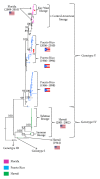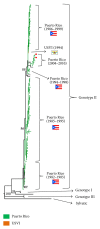Dengue in the United States of America: a worsening scenario?
- PMID: 23865061
- PMCID: PMC3705843
- DOI: 10.1155/2013/678645
Dengue in the United States of America: a worsening scenario?
Abstract
Dengue is a febrile illness caused by any of the four dengue virus types (DENV-1 to -4, genus Flavivirus, family Flaviviridae) mainly transmitted by the mosquito Aedes aegypti. DENV can be transmitted by blood transfusion. Dengue has been historically present in the continental United States (US), in the state of Hawaii, and in the US insular territories in the Caribbean and the Pacific. During the second half of the 20th century, most of the cases reported in the US were imported cases brought to the country by travelers. Since 2009, cases of autochthonous dengue have been recognized in the state of Florida after 75 years of absence, followed by intensification of transmission in endemic places including the US territories of US Virgin Islands and Puerto Rico, which experienced a large dengue epidemic in 2010. The widespread distribution of dengue mosquito vectors, deficient mosquito control measures and increased frequency of DENV-infected visitors to the US coming from dengue-endemic locations or places experiencing epidemics appear to be jointly responsible for the emergence and reemergence of dengue in the US and its territories.
Figures




References
-
- World Health Organization. Dengue Haemorrhagic Fever: Diagnosis, Treatment, Prevention and Control. 2nd edition. Geneva, Switzerland: World Health Organization; 1997.
-
- World Health Organization. Dengue: Guidelines for Diagnosis, Treatment, Prevention and Control. New edition. Geneva, Switzerland: World Health Organization; 2009. - PubMed
-
- Mohammed H, Linnen JM, Muhoz-Jorddn JL, et al. Dengue virus in blood donations, Puerto Rico, 2005. Transfusion. 2008;48(7):1348–1354. - PubMed
-
- Tangnararatchakit K, Tirapanich W, Tapaneya-Olarn W, et al. Severe nonfebrile dengue infection in an adolescent after postoperative kidney transplantation: a case report. Transplantation Proceedings. 2012;44(1):303–306. - PubMed
Publication types
MeSH terms
LinkOut - more resources
Full Text Sources
Other Literature Sources
Medical

